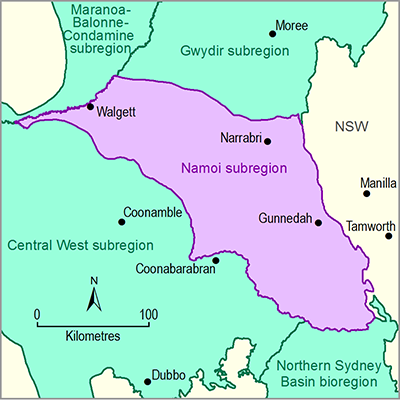- Home
- Assessments
- Bioregional Assessment Program
- Namoi subregion
- 3-4 Impact and risk analysis for the Namoi subregion
- 3.4 Impacts on and risks to landscape classes
- 3.4.6 Potentially impacted landscape classes lacking quantitative ecological modelling
The ‘Grassy woodland GDE’ landscape class within the zone of potential hydrological change, comprises most of the non-riverine landscapes in the Pilliga region (561.7 km2), and only a small portion (72.8 km2) of the total 634.7 km2 of this landscape class is located outside of the Pilliga region. The qualitative modelling identified maximum groundwater drawdown as the relevant hydrological response variable, although no quantitative modelling was done (Table 16 and see Section 2.7.5.2.2 in companion product 2.7 for the Namoi subregion (Ickowicz et al., 2018)). The groundwater modelling indicates that 13.9 km2 of this landscape class are exposed to a 50% chance of greater than 2 m drawdown due to additional coal resource development. Although the experts expressed some uncertainty around the likelihood of groundwater dependency in some of the vegetation types classified as ‘Grassy woodland GDE’, these results suggest further investigation into the nature of water dependency for this landscape class is required.
The ‘Rainforest’ landscape group occupies a limited area within the zone of potential hydrological change, with the ‘Rainforest’ landscape class intersecting with 4.1 km2 of the zone and ‘Rainforest GDE’ only 0.3 km2 (Table 16). The qualitative model formulated for the ‘Rainforest’ landscape group identified groundwater drawdown as the key hydrological response variable. However, the types of groundwater flow systems in areas where rainforest occurs in the Namoi assessment extent are unlikely to be impacted due to additional coal resource development. In the upland and outcropping landscape positions where rainforests tend to occur in the subregion, groundwater is usually expressed at the surface through localised flow paths (i.e. cracks and fissures) originating in the nearby recharge areas.
Two springs are known to occur within the zone of potential hydrological change. They are classified as ‘GAB springs’ given their association with underlying sandstone formations. These two springs are located on the eastern edge of the Pilliga Basin and are thought to be primarily recharge springs given their location on the eastern fringes of the GAB (Fensham and Fairfax, 2003). These two springs are identified as Eather and Hardy’s springs and are considered high-priority GDEs by the Namoi region state of the catchment report (OEH, 2010b). Field surveys of these two springs reported that they are located on sites proximal to the interface between Pilliga Sandstone and Purlawaugh Formation, which is a hydrogeologically likely place for springs to occur (Santos, 2017). This study also notes that the springs have poor ecological condition and have been highly modified or disturbed (i.e. site excavated and dammed) (Santos, 2017).
A qualitative model was formulated for a typical recharge GAB spring and identified changes in maximum groundwater drawdown as a key response variable for the ecosystem typically supported by GAB springs of this kind (Table 16, further details are provided in Section 2.7.6 of companion product 2.7 for the Namoi subregion (Ickowicz et al., 2018)). There is a 5% chance of greater than 0.2 m drawdown for both of the springs within the zone of potential hydrological change (data not shown). It is unclear whether these springs source their water from the regional watertable used to define the zone, so it is not known whether they are potentially impacted. The classification as GAB springs is based on their association with underlying sandstone formations; their connection to the GAB requires further investigation.

Product Finalisation date
- 3.1 Overview
- 3.2 Methods
- 3.3 Potential hydrological changes
- 3.4 Impacts on and risks to landscape classes
- 3.4.1 Overview
- 3.4.2 Landscape classes that are unlikely to be impacted
- 3.4.3 'Floodplain or lowland riverine' (non-Pilliga) landscape group
- 3.4.4 'Non-floodplain or upland riverine' (non-Pilliga) landscape group
- 3.4.5 Pilliga riverine (upland and lowland)
- 3.4.6 Potentially impacted landscape classes lacking quantitative ecological modelling
- References
- Datasets
- 3.5 Impacts on and risks to water-dependent assets
- 3.6 Commentary for coal resource developments that are not modelled
- 3.7 Conclusion
- Citation
- Acknowledgements
- Contributors to the Technical Programme
- About this technical product
